Sahar Vahdati
Nature-inspired machine intelligence group, SCaDS.AI center, Technical University of Dresden, Germany Institute for Applied Computer Science, InfAI - Dresden, Germany
SCI-IDEA: Context-Aware Scientific Ideation Using Token and Sentence Embeddings
Mar 25, 2025Abstract:Every scientific discovery starts with an idea inspired by prior work, interdisciplinary concepts, and emerging challenges. Recent advancements in large language models (LLMs) trained on scientific corpora have driven interest in AI-supported idea generation. However, generating context-aware, high-quality, and innovative ideas remains challenging. We introduce SCI-IDEA, a framework that uses LLM prompting strategies and Aha Moment detection for iterative idea refinement. SCI-IDEA extracts essential facets from research publications, assessing generated ideas on novelty, excitement, feasibility, and effectiveness. Comprehensive experiments validate SCI-IDEA's effectiveness, achieving average scores of 6.84, 6.86, 6.89, and 6.84 (on a 1-10 scale) across novelty, excitement, feasibility, and effectiveness, respectively. Evaluations employed GPT-4o, GPT-4.5, DeepSeek-32B (each under 2-shot prompting), and DeepSeek-70B (3-shot prompting), with token-level embeddings used for Aha Moment detection. Similarly, it achieves scores of 6.87, 6.86, 6.83, and 6.87 using GPT-4o under 5-shot prompting, GPT-4.5 under 3-shot prompting, DeepSeek-32B under zero-shot chain-of-thought prompting, and DeepSeek-70B under 5-shot prompting with sentence-level embeddings. We also address ethical considerations such as intellectual credit, potential misuse, and balancing human creativity with AI-driven ideation. Our results highlight SCI-IDEA's potential to facilitate the structured and flexible exploration of context-aware scientific ideas, supporting innovation while maintaining ethical standards.
Why do you cite? An investigation on citation intents and decision-making classification processes
Jul 18, 2024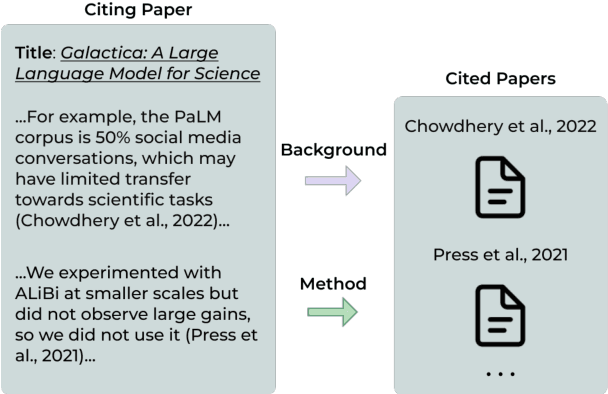
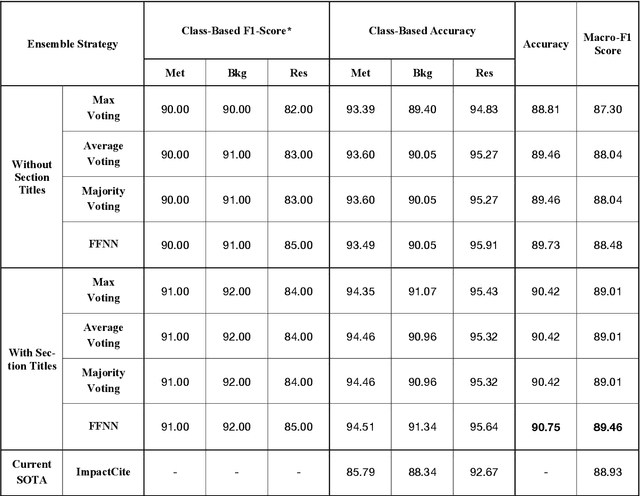

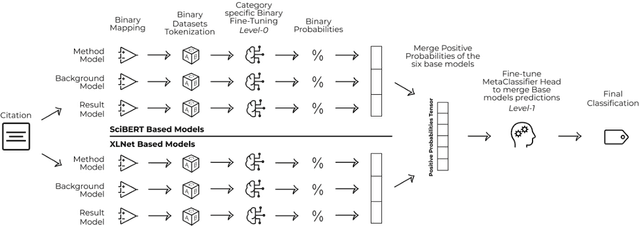
Abstract:Identifying the reason for which an author cites another work is essential to understand the nature of scientific contributions and to assess their impact. Citations are one of the pillars of scholarly communication and most metrics employed to analyze these conceptual links are based on quantitative observations. Behind the act of referencing another scholarly work there is a whole world of meanings that needs to be proficiently and effectively revealed. This study emphasizes the importance of trustfully classifying citation intents to provide more comprehensive and insightful analyses in research assessment. We address this task by presenting a study utilizing advanced Ensemble Strategies for Citation Intent Classification (CIC) incorporating Language Models (LMs) and employing Explainable AI (XAI) techniques to enhance the interpretability and trustworthiness of models' predictions. Our approach involves two ensemble classifiers that utilize fine-tuned SciBERT and XLNet LMs as baselines. We further demonstrate the critical role of section titles as a feature in improving models' performances. The study also introduces a web application developed with Flask and currently available at http://137.204.64.4:81/cic/classifier, aimed at classifying citation intents. One of our models sets as a new state-of-the-art (SOTA) with an 89.46% Macro-F1 score on the SciCite benchmark. The integration of XAI techniques provides insights into the decision-making processes, highlighting the contributions of individual words for level-0 classifications, and of individual models for the metaclassification. The findings suggest that the inclusion of section titles significantly enhances classification performances in the CIC task. Our contributions provide useful insights for developing more robust datasets and methodologies, thus fostering a deeper understanding of scholarly communication.
Retention Is All You Need
Apr 06, 2023



Abstract:Skilled employees are usually seen as the most important pillar of an organization. Despite this, most organizations face high attrition and turnover rates. While several machine learning models have been developed for analyzing attrition and its causal factors, the interpretations of those models remain opaque. In this paper, we propose the HR-DSS approach, which stands for Human Resource Decision Support System, and uses explainable AI for employee attrition problems. The system is designed to assist human resource departments in interpreting the predictions provided by machine learning models. In our experiments, eight machine learning models are employed to provide predictions, and the results achieved by the best-performing model are further processed by the SHAP explainability process. We optimize both the correctness and explanation of the results. Furthermore, using "What-if-analysis", we aim to observe plausible causes for attrition of an individual employee. The results show that by adjusting the specific dominant features of each individual, employee attrition can turn into employee retention through informative business decisions. Reducing attrition is not only a problem for any specific organization but also, in some countries, becomes a significant societal problem that impacts the well-being of both employers and employees.
Language Model-driven Negative Sampling
Mar 09, 2022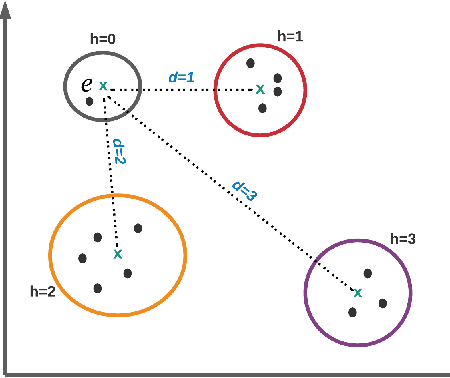


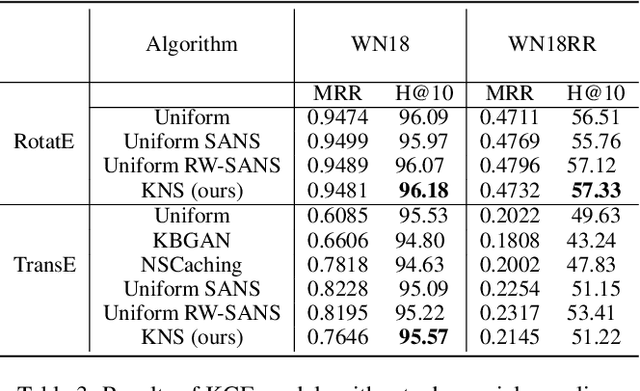
Abstract:Knowledge Graph Embeddings (KGEs) encode the entities and relations of a knowledge graph (KG) into a vector space with a purpose of representation learning and reasoning for an ultimate downstream task (i.e., link prediction, question answering). Since KGEs follow closed-world assumption and assume all the present facts in KGs to be positive (correct), they also require negative samples as a counterpart for learning process for truthfulness test of existing triples. Therefore, there are several approaches for creating negative samples from the existing positive ones through a randomized distribution. This choice of generating negative sampling affects the performance of the embedding models as well as their generalization. In this paper, we propose an approach for generating negative sampling considering the existing rich textual knowledge in KGs. %The proposed approach is leveraged to cluster other relevant representations of the entities inside a KG. Particularly, a pre-trained Language Model (LM) is utilized to obtain the contextual representation of symbolic entities. Our approach is then capable of generating more meaningful negative samples in comparison to other state of the art methods. Our comprehensive evaluations demonstrate the effectiveness of the proposed approach across several benchmark datasets for like prediction task. In addition, we show cased our the functionality of our approach on a clustering task where other methods fall short.
Trans4E: Link Prediction on Scholarly Knowledge Graphs
Jul 03, 2021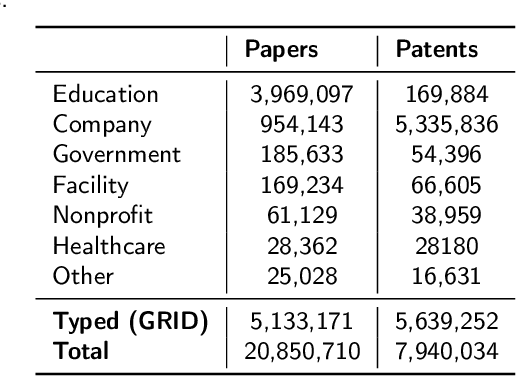
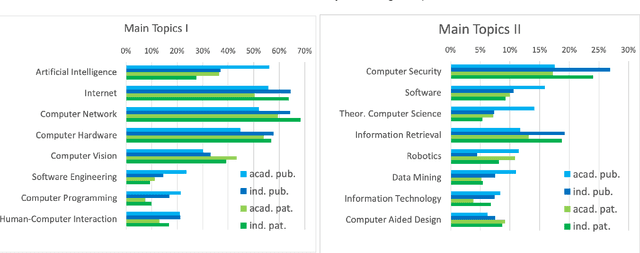

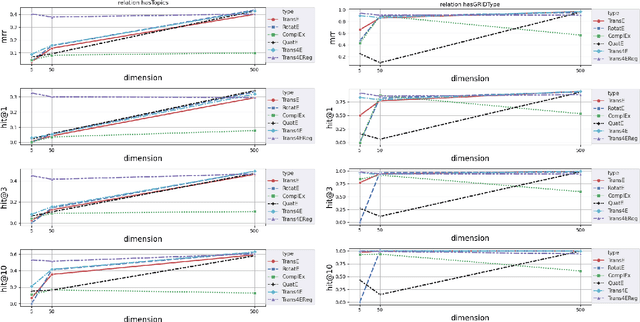
Abstract:The incompleteness of Knowledge Graphs (KGs) is a crucial issue affecting the quality of AI-based services. In the scholarly domain, KGs describing research publications typically lack important information, hindering our ability to analyse and predict research dynamics. In recent years, link prediction approaches based on Knowledge Graph Embedding models became the first aid for this issue. In this work, we present Trans4E, a novel embedding model that is particularly fit for KGs which include N to M relations with N$\gg$M. This is typical for KGs that categorize a large number of entities (e.g., research articles, patents, persons) according to a relatively small set of categories. Trans4E was applied on two large-scale knowledge graphs, the Academia/Industry DynAmics (AIDA) and Microsoft Academic Graph (MAG), for completing the information about Fields of Study (e.g., 'neural networks', 'machine learning', 'artificial intelligence'), and affiliation types (e.g., 'education', 'company', 'government'), improving the scope and accuracy of the resulting data. We evaluated our approach against alternative solutions on AIDA, MAG, and four other benchmarks (FB15k, FB15k-237, WN18, and WN18RR). Trans4E outperforms the other models when using low embedding dimensions and obtains competitive results in high dimensions.
Multiple Run Ensemble Learning withLow-Dimensional Knowledge Graph Embeddings
Apr 11, 2021



Abstract:Among the top approaches of recent years, link prediction using knowledge graph embedding (KGE) models has gained significant attention for knowledge graph completion. Various embedding models have been proposed so far, among which, some recent KGE models obtain state-of-the-art performance on link prediction tasks by using embeddings with a high dimension (e.g. 1000) which accelerate the costs of training and evaluation considering the large scale of KGs. In this paper, we propose a simple but effective performance boosting strategy for KGE models by using multiple low dimensions in different repetition rounds of the same model. For example, instead of training a model one time with a large embedding size of 1200, we repeat the training of the model 6 times in parallel with an embedding size of 200 and then combine the 6 separate models for testing while the overall numbers of adjustable parameters are same (6*200=1200) and the total memory footprint remains the same. We show that our approach enables different models to better cope with their expressiveness issues on modeling various graph patterns such as symmetric, 1-n, n-1 and n-n. In order to justify our findings, we conduct experiments on various KGE models. Experimental results on standard benchmark datasets, namely FB15K, FB15K-237 and WN18RR, show that multiple low-dimensional models of the same kind outperform the corresponding single high-dimensional models on link prediction in a certain range and have advantages in training efficiency by using parallel training while the overall numbers of adjustable parameters are same.
Motif Learning in Knowledge Graphs Using Trajectories Of Differential Equations
Oct 18, 2020



Abstract:Knowledge Graph Embeddings (KGEs) have shown promising performance on link prediction tasks by mapping the entities and relations from a knowledge graph into a geometric space (usually a vector space). Ultimately, the plausibility of the predicted links is measured by using a scoring function over the learned embeddings (vectors). Therefore, the capability in preserving graph characteristics including structural aspects and semantics highly depends on the design of the KGE, as well as the inherited abilities from the underlying geometry. Many KGEs use the flat geometry which renders them incapable of preserving complex structures and consequently causes wrong inferences by the models. To address this problem, we propose a neuro differential KGE that embeds nodes of a KG on the trajectories of Ordinary Differential Equations (ODEs). To this end, we represent each relation (edge) in a KG as a vector field on a smooth Riemannian manifold. We specifically parameterize ODEs by a neural network to represent various complex shape manifolds and more importantly complex shape vector fields on the manifold. Therefore, the underlying embedding space is capable of getting various geometric forms to encode complexity in subgraph structures with different motifs. Experiments on synthetic and benchmark dataset as well as social network KGs justify the ODE trajectories as a means to structure preservation and consequently avoiding wrong inferences over state-of-the-art KGE models.
5* Knowledge Graph Embeddings with Projective Transformations
Jun 08, 2020



Abstract:Performing link prediction using knowledge graph embedding (KGE) models is a popular approach for knowledge graph completion. Such link predictions are performed by measuring the likelihood of links in the graph via a transformation function that maps nodes via edges into a vector space. Since the complex structure of the real world is reflected in multi-relational knowledge graphs, the transformation functions need to be able to represent this complexity. However, most of the existing transformation functions in embedding models have been designed in Euclidean geometry and only cover one or two simple transformations. Therefore, they are prone to underfitting and limited in their ability to embed complex graph structures. The area of projective geometry, however, fully covers inversion, reflection, translation, rotation, and homothety transformations. We propose a novel KGE model, which supports those transformations and subsumes other state-of-the-art models. The model has several favorable theoretical properties and outperforms existing approaches on widely used link prediction benchmarks.
Adaptive Margin Ranking Loss for Knowledge Graph Embeddings via a Correntropy Objective Function
Jul 09, 2019



Abstract:Translation-based embedding models have gained significant attention in link prediction tasks for knowledge graphs. TransE is the primary model among translation-based embeddings and is well-known for its low complexity and high efficiency. Therefore, most of the earlier works have modified the score function of the TransE approach in order to improve the performance of link prediction tasks. Nevertheless, proven theoretically and experimentally, the performance of TransE strongly depends on the loss function. Margin Ranking Loss (MRL) has been one of the earlier loss functions which is widely used for training TransE. However, the scores of positive triples are not necessarily enforced to be sufficiently small to fulfill the translation from head to tail by using relation vector (original assumption of TransE). To tackle this problem, several loss functions have been proposed recently by adding upper bounds and lower bounds to the scores of positive and negative samples. Although highly effective, previously developed models suffer from an expansion in search space for a selection of the hyperparameters (in particular the upper and lower bounds of scores) on which the performance of the translation-based models is highly dependent. In this paper, we propose a new loss function dubbed Adaptive Margin Loss (AML) for training translation-based embedding models. The formulation of the proposed loss function enables an adaptive and automated adjustment of the margin during the learning process. Therefore, instead of obtaining two values (upper bound and lower bound), only the center of a margin needs to be determined. During learning, the margin is expanded automatically until it converges. In our experiments on a set of standard benchmark datasets including Freebase and WordNet, the effectiveness of AML is confirmed for training TransE on link prediction tasks.
Soft Marginal TransE for Scholarly Knowledge Graph Completion
Apr 27, 2019



Abstract:Knowledge graphs (KGs), i.e. representation of information as a semantic graph, provide a significant test bed for many tasks including question answering, recommendation, and link prediction. Various amount of scholarly metadata have been made vailable as knowledge graphs from the diversity of data providers and agents. However, these high-quantities of data remain far from quality criteria in terms of completeness while growing at a rapid pace. Most of the attempts in completing such KGs are following traditional data digitization, harvesting and collaborative curation approaches. Whereas, advanced AI-related approaches such as embedding models - specifically designed for such tasks - are usually evaluated for standard benchmarks such as Freebase and Wordnet. The tailored nature of such datasets prevents those approaches to shed the lights on more accurate discoveries. Application of such models on domain-specific KGs takes advantage of enriched meta-data and provides accurate results where the underlying domain can enormously benefit. In this work, the TransE embedding model is reconciled for a specific link prediction task on scholarly metadata. The results show a significant shift in the accuracy and performance evaluation of the model on a dataset with scholarly metadata. The newly proposed version of TransE obtains 99.9% for link prediction task while original TransE gets 95%. In terms of accuracy and Hit@10, TransE outperforms other embedding models such as ComplEx, TransH and TransR experimented over scholarly knowledge graphs
 Add to Chrome
Add to Chrome Add to Firefox
Add to Firefox Add to Edge
Add to Edge